What is leprosy?
Leprosy is a bacterial infectious disease that mainly affects people in developing countries, including Brazil, Bangladesh, India, the Democratic Republic of the Congo and Nigeria.
- In these regions, the annual incidence The leprosy rate is around one in 100 000 inhabitants, which is less than necessary to consider it endemic disease.
- Leprosy is caused by Mycobacterium leprae, which grows very slowly and is generally transmitted by air.
- The classic clinical pattern of leprosy involves the skin, nervesand nasal and oropharyngeal mucous membrane. Leprosy can lead to significant disability and stigmatization.
- Curative treatment for the undetermined stage of leprosy includes rifampin and dapsone; Clofazimine is added to the multibacillary leprosy form (which has numerous bacilli).
- A immune the disorder can occur during the course of the disease; This is called a leprosy reaction.
- Reactions to leprosy occur mainly after treatment for leprosy is started, but can also occur without treatment.
Type 1 leprosy reaction
What is a type 1 leprosy reaction?
Type 1 leprosy reaction is a type of delay hypersensitivity to M. leprae antigens. Also called leprosy reaction 1.
- The type 1 leprosy reaction occurs more frequently after treatment for leprosy has started, but it can also occur before and after treatment.
- Reflects a strengthening of specificity cellular immunity against M. leprae towards the tuberculoid type.
Type 1 leprosy reactions in borderline tuberculoid leprosy
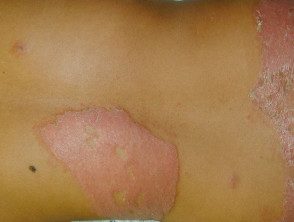
Borderline tuberculoid leprosy with type 1 reaction

Courtesy
Who has the type 1 leprosy reaction?
The leprosy 1 reaction is unpredictable. It occurs in patients with borderline disease; that is, the transition between tuberculoid leprosy and lepromatous leprosy.
The classification of limit leprosy includes:
- Borderline tuberculoid leprosy
- Borderline borderline leprosy
- Lepromatous leprosy limit.
What are the clinical characteristics of the type 1 leprosy reaction?
Type 1 leprosy reactions generally affect the skin and nerves, and there is no systemic Symptoms The reaction is classified as mild or severe.
The cutaneous signs of the type 1 leprosy reaction include:
- Erythema and hardening of existing injuries
- Ulceration during very intense reactions
Nervous participation in the reaction of leprosy type 1 and:
- It mainly affects elbowexternal sciatic popliteal, facial and cervical nerves
- It often produces pain or tenderness.
- It can cause loss of function for more than a few days, it can cause muscle weakness, loss of sensation, paralysisor deformity.
A mild type 1 leprosy reaction is characterized by a few swollen plates and without nerve damage. A severe type 1 leprosy reaction is characterized by many inflamed plaques and nerve damage.
How is a type 1 leprosy reaction diagnosed?
A type 1 leprosy reaction is clinically suspected in a patient with borderline leprosy who develops symptoms within a few months of starting treatment.
There are no routine laboratory tests. A skin biopsy can reveal:
- Granulomas
- Multinucleate giant cells
- Edema.
No increase in polymorphonuclear neutrophils in the patient's blood count or a change in C-reactive protein (CRP) levels. Type 1 leprosy reactions have been associated with elevated levels of serum chemokine 10)
What is the treatment for a type 1 leprosy reaction?
A mild leprosy 1 reaction requires supportive care. This involves:
- Current steroids
- Analgesics
- Supervision.
A severe type 1 leprosy reaction with nerve failure requires immediate treatment.
- The first-line treatment is prednisone or prednisolone 0.5–1 mg / kg / day until inflammation It has been reduced, followed by a slow dose decrease.
Cyclosporine is a second-line treatment for severe type 1 reactions not controlled by prednisone.
- Neurolysis or nerve surgery to relieve pressure may be necessary if deterioration of the nerve persists.
- Treatment with rifampin, dapsone, and / or clofazimine should continue.
What is the result of a type 1 leprosy reaction?
The natural course of an untreated type 1 leprosy reaction is for it to persist for several months.
- Skin lesions continue to swell and may become confluent.
- Nerve disturbance can be very serious, leading to loss of function and disability.
Type 2 leprosy reaction
What is a type 2 leprosy reaction?
A type 2 leprosy reaction is characterized by a acute immune complex vasculitis affecting the skin and other organs. It is poorly understood. Also called leprosy 2 reaction or erythema nodosum leprosum.
Type 2 leprosy reactions

Leprosy erythema nodosum

Leprosy erythema nodosum
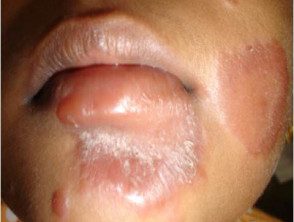
Courtesy of Professor Jayamini Seneviratne
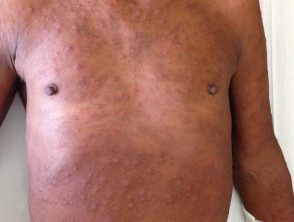
Leprosy type 2 reaction
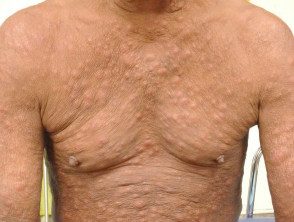
Leprosy type 2 reaction
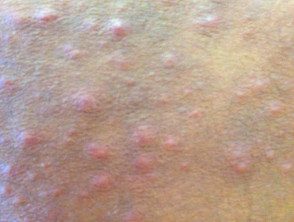
Leprosy type 2 reaction
Who has the type 2 leprosy reaction?
The type 2 leprosy reaction occurs in patients with:
- Lepromatous leprosy
- Lepromatous leprosy limit.
The type 2 leprosy reaction is commonly associated with:
- Puberty
- The pregnancy
- Lactation.
What are the clinical characteristics of the type 2 leprosy reaction?
The clinical characteristics of leprosy 2 reactions depend on their severity and the organs affected.
In type 2 leprosy reaction, the skin may show:
- Lesions spread to any part of the body (mainly the extensor muscle appearance of the limbs and face).
- Painful small red multiple nodules
- Sterile pustules and ulcers
- Lesions can be superficial or deep in the dermis.
Other clinical features of the type 2 leprosy reaction may include:
- Iridocyclitis (inflammation of the eye)
- Orchitis (inflammation of a testicle)
- Renal kidney failure or failure
- Proteinuria (excess protein in the urine)
- Cytolytic cholestasis (inability to produce bile)
- Fever
- Fatigue
- Enlarged lymph nodes
- Painful swelling in the red joints.
How is a type 2 leprosy reaction diagnosed?
A type 2 leprosy reaction is clinically suspected if a patient with lepromatous leprosy or borderline lepromatous leprosy complains of fever and fatigue and has multiple painful nodules on red skin, whether or not they have received treatment.
Blood tests show high inflammatory These include:
- A high white blood cell count
- A high level of protein C
- Kidney and liver failure (occasionally).
Pathology It is essential to confirm the type 2 leprosy reaction. A biopsy of a new red. nodule shows less than 24 hours:
- A infiltrate of overlapping polymorphs in chronic inflammation
- A large bacterial load of M. leprae (special stains may be required).
What is the treatment for a type 2 leprosy reaction?
Treatment depends on the severity of the type 2 leprosy reaction as clinically evaluated and supported by laboratory tests. A slight cutaneous The reaction without other organ damage can be managed with supportive care. This includes:
- Analgesics
- Control fever
- Regular monitoring.
Treatment for severe type 2 leprosy reactions may include:
Prednisone at a dose of approximately 1 mg / kg / day, decreasing rapidly
Clofazimine (note that the multibacillary regimen with clofazimine prevents type 2 leprosy reactions)
Thalidomide 400 mg / day for 5–10 days, gradually decreasing over 1–2 months.
Cyclosporine, azathioprine, methotrexate, mycophenolate mofetil, and pentoxifylline have been used successfully in small trials.
What is the result of a type 2 leprosy reaction?
Without treatment, type 2 leprosy reactions continue for about 2 weeks and then stabilize. Recurrences are frequent.
Untreated type 2 leprosy reactions can lead to kidney failure requiring dialysisliver failure requiring transplant, blindness and / or long-term inflammation of the testicles.
Pike phenomenon
Lucio's phenomenon is a very rare, acute and serious complication of long-standing, untreated lepromatous leprosy. It can be deadly.
- It occurs mainly in patients of Mexican descent.
- It comes with multiple perforations and necrotic ulcers.
Lucio's phenomenon is treated intensively with systemic steroids.
Ulceration of the leg due to the phenomenon of Lucio in leprosy
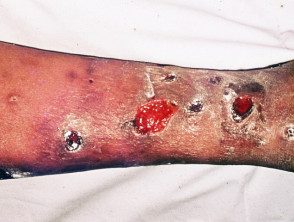
Pike phenomenon in leprosy

Pike phenomenon in leprosy
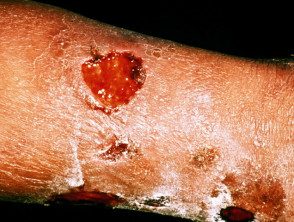
Pike phenomenon in leprosy

